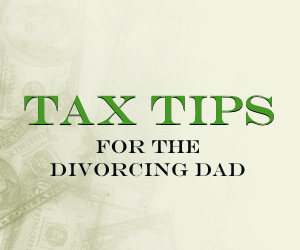 By Tara N. Brewer
By Tara N. Brewer
Special to DadsDivorce.com
As you scramble to file taxes before the deadline, many divorced dads or separated parents face two questions. Who can claim the dependent/s and what tax breaks can I qualify for?
For tax purposes, children are dependents. The parent raising the dependent the majority of the time is considered the custodial parent. The other parent is considered the noncustodial parent.
If the child lived with each parent for an equal amount of time, then the custodial parent would be deemed the parent with the higher adjusted gross income.
Generally, the custodial parent can claim the children for tax purposes. However, according to an article in the Wall Street Journal, there are exceptions to this rule that allow the noncustodial parent to claim the children. The noncustodial parent must follow certain rules to even be considered for these exceptions.
Those rules are:
1. Over half of the child’s support for the year must be provided by one or both parents.
2. Parents must be divorced or separated under written agreement at the end of the year or have lived apart half of the year.
3. The child must be in the custody of either parent over half of the year.
4. The custodial parent must sign a written declaration allowing the noncustodial parent to claim the child.
Cordell & Cordell divorce lawyer Richard Coffee said many noncustodial parents assume that the custodial parent gets to claim the child and don’t pursue the issue.
However, if the noncustodial parent pays significant support to the custodial parent and/or exercises more than usual visitation, there is a valid claim. Also, per the court, multiple children can be split for tax purposes.
Additionally, the noncustodial parent can have an experienced family law attorney review the custodial parent’s financial statement for suspect or extravagant expenses.
Related Articles:
The custodial parent can file the head of household and receive the earned-income tax credit. For 2012, the earned income tax credit can be worth up to $3,169 for one child and up to $5,891 for 3 or more children. This credit is not valid if the parent’s income goes up.
According to IRS.gov, the custodial parent can also receive the child care tax credit, ranging from $600 to $1,050 for one child and $1,200 to $2,100 for 2 or more children, based on the parent’s income. The child involved in the child tax credit has to be under age 17 at the end of the year.
Another break is the tax-free childcare assistance. This break allows up to $5,000 in tax-free reimbursements for childcare expenses under the employer plan.
Some tax breaks are available for both the custodial and noncustodial parent. They can receive tax breaks for the child’s medical expenses, tax-free employer-provided healthcare benefits for the child, and tax-free health savings account (HSA) distributions to cover the child’s medical expenses.
Additionally, the noncustodial parent can be eligible for the following tax breaks:
1. Higher Education Tax Credit: for college-age children. The American Opportunity credit worth up to $2,500 for the child’s first four college years and the Lifetime Learning credit worth up to $2,000 for the child’s higher education schooling.
2. Student Loan Interest Deduction: worth up to $2,500 for interest paid on the child’s student loans.
3. Tuition Deduction: worth up to $4,000 for higher education tuition and enrollment fees. This amount could drop to $2,000 for a higher income parent.
If you would like to discuss any tax breaks you qualify for as a custodial or noncustodial parent, please contact a Cordell & Cordell office.

